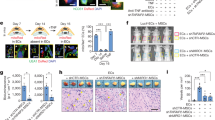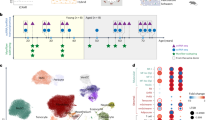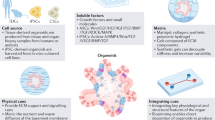Abstract
Stem cells have emerged as a next-generation therapy for cardiovascular disease. Initial clinical trials in patients with myocardial infarction document improved cardiac performance after administration of stem cells, translating their regenerative potential from the bench to the bedside. However, the promise of stem cell-based therapy has yet to be fully exploited, in part due to varying degrees of efficacy on follow-up. Contributing to the uncertain outcome is the variable cardiogenic potential of patient-derived stem cells. A strategy mimicking cardiogenic signaling was here formulated to transform mesenchymal stem cells, derived from human bone marrow, into cardiac progenitors. We identified a set of recombinant trophic factors capable of collectively inducing nuclear translocation of cardiac-specific transcription factors, engaging mesenchymal stem cells into cardiopoiesis, and ultimately securing a phenotype with functional excitation–contraction coupling. Maximizing the cardiogenic potential of human mesenchymal stem cells achieves a critical step in optimizing therapeutic translation.
This is a preview of subscription content, access via your institution
Access options
Subscribe to this journal
Receive 12 print issues and online access
$209.00 per year
only $17.42 per issue
Buy this article
- Purchase on Springer Link
- Instant access to full article PDF
Prices may be subject to local taxes which are calculated during checkout


Similar content being viewed by others
References
Anversa P and Nadal-Ginard B (2002) Myocyte renewal and ventricular remodelling. Nature 415: 240–243
Towbin JA and Bowles NE (2002) The failing heart. Nature 415: 227–233
Beltrami AP et al. (2003) Adult cardiac stem cells are multipotent and support myocardial regeneration. Cell 114: 763–776
Laugwitz KL et al. (2005) Postnatal isl1+ cardioblasts enter fully differentiated cardiomyocyte lineages. Nature 433: 647–653
Dimmeler S et al. (2005) Unchain my heart: the scientific foundations of cardiac repair. J Clin Invest 115: 572–583
Wollert KC and Drexler H (2005) Clinical applications of stem cells for the heart. Circ Res 96: 151–163
Menasché P et al. (2003) Autologous skeletal myoblast transplantation for severe postinfarction left ventricular dysfunction. J Am Coll Cardiol 41: 1078–1083
Schächinger V et al. (2004) Transplantation of progenitor cells and regeneration enhancement in acute myocardial infarction: final one-year results of the TOPCARE-AMI trial. J Am Coll Cardiol 44: 1690–1699
Wollert KC et al. (2004) Intracoronary autologous bone-marrow cell transfer after myocardial infarction: the BOOST randomised controlled clinical trial. Lancet 364: 141–148
Fernández-Avilés F et al. (2004) Experimental and clinical regenerative capability of human bone marrow cells after myocardial infarction. Circ Res 95: 742–748
Perin EC et al. (2004) Improved exercise capacity and ischemia 6 and 12 months after transendocardial injection of autologous bone marrow mononuclear cells for ischemic cardiomyopathy. Circulation 110: II213–II218
Gnecchi M et al. (2005) Paracrine action accounts for marked protection of ischemic heart by Akt-modified mesenchymal stem cells. Nat Med 11: 367–368
Fraidenraich D et al. (2004) Rescue of cardiac defects in Id knockout embryos by injection of embryonic stem cells. Science 306: 247–252
Orlic D et al. (2001) Bone marrow cells regenerate infarcted myocardium. Nature 410: 701–705
Murry CE et al. (2004) Hematopoietic stem cells do not transdifferentiate into cardiac myocytes in myocardial infarcts. Nature 428: 664–668
Nygren JM et al. (2004) Bone marrow-derived hematopoietic cells generate cardiomyocytes at a low frequency through cell fusion, but not transdifferentiation. Nat Med 10: 494–501
Behfar A et al. (2002) Stem cell differentiation requires a paracrine pathway in the heart. FASEB J 16: 1558–1566
Perez-Terzic C et al. (2003) Structural adaptation of the nuclear pore complex in stem cell-derived cardiomyocytes. Circ Res 92: 444–452
Hodgson DM et al. (2004) Stable benefit of embryonic stem cell therapy in myocardial infarction. Am J Physiol 287: H471–H479
Foley A and Mercola M (2004) Heart induction: embryology to cardiomyocyte regeneration. Trends Cardiovasc Med 14: 121–125
Jiang Y et al. (2002) Pluripotency of mesenchymal stem cells derived from adult marrow. Nature 418: 41–49
Tomita S et al. (1999) Autologous transplantation of bone marrow cells improves damaged heart function. Circulation 100: II247–II256
Koh SH et al. (2005) Co-culture of human CD34+ cells with mesenchymal stem cells increases the survival of CD34+ cells against the 5-aza-deoxycytidine- or trichostatin A-induced cell death. Biochem Biophys Res Commun 329: 1039–1045
Behfar A et al. (2005) Administration of allogenic stem cells dosed to secure cardiogenesis and sustained infarct repair. Ann NY Acad Sci 1049: 189–198
Olson EN and Schneider MD (2003) Sizing up the heart: development redux in disease. Genes Dev 17: 1937–1956
Pittenger MF and Martin BJ (2004) Mesenchymal stem cells and their potential as cardiac therapeutics. Circ Res 95: 9–20
Hodgson DM et al. (2003) Cellular remodeling in heart failure disrupts KATP channel-dependent stress tolerance. EMBO J 22: 1732–1742
Behfar A et al. (2004) Newly identified cardiopoietic stem cell population recruited by TNF-α from pluripotent embryonic cells [abstract]. Circulation 110: III-302
Behfar A et al. (2005) Guided cardiogenesis for safe stem cell-based therapy [abstract]. Clin Pharmacol Ther 77: P3
Mummery C et al. (2003) Differentiation of human embryonic stem cells to cardiomyocytes: role of coculture with visceral endoderm-like cells. Circulation 107: 2733–2740
Acknowledgements
We thank DL Mann and C Mummery for the generous gifts of TNF-α-transgenic mice and endodermal cells, RS Faustino and RB Dyer for expert assistance, and S Vuk-Pavlovic for guidance and discussion. This work was supported by the National Institutes of Health, the Marriott Heart Disease Research Program, the Marriott Foundation, the Ted Nash Long Life Foundation, the Ralph Wilson Medical Research Foundation, and the Miami Heart Research Institute.
Author information
Authors and Affiliations
Corresponding author
Ethics declarations
Competing interests
The authors declare no competing financial interests.
Rights and permissions
About this article
Cite this article
Behfar, A., Terzic, A. Derivation of a cardiopoietic population from human mesenchymal stem cells yields cardiac progeny. Nat Rev Cardiol 3 (Suppl 1), S78–S82 (2006). https://doi.org/10.1038/ncpcardio0429
Received:
Accepted:
Issue Date:
DOI: https://doi.org/10.1038/ncpcardio0429
This article is cited by
-
Cardiopoietic stem cell therapy restores infarction-altered cardiac proteome
npj Regenerative Medicine (2020)
-
Cellular self-assembly into 3D microtissues enhances the angiogenic activity and functional neovascularization capacity of human cardiopoietic stem cells
Angiogenesis (2019)
-
Mechanisms of stem cell based cardiac repair-gap junctional signaling promotes the cardiac lineage specification of mesenchymal stem cells
Scientific Reports (2017)
-
Systems-Based Technologies in Profiling the Stem Cell Molecular Framework for Cardioregenerative Medicine
Stem Cell Reviews and Reports (2015)
-
Cell therapy for cardiac repair—lessons from clinical trials
Nature Reviews Cardiology (2014)



